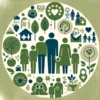In my work, I notice a common theme centered around the misconception that there is a universal remedy for complex issues such as community health. Effective responses require us not to just tell individuals and communities how to “fix it” but require deep listening and compassion. They necessitate building genuine relationships between serving agencies and individuals and the community. This process involves going beyond surface-level solutions to understand the underlying causes and unique dynamics of each community's health challenges. Only through such empathetic engagement and collaboration can we hope to devise solutions that are both impactful and sustainable.
The Pitfall of the Panacea
Quick fixes in the world of problem-solving are like opting for duct tape to manage a leak: a temporary solution that often leads to bigger puddles down the line. Let's take a dive into this idea with a story. Picture me discussing the challenge of statewide travel with a group of billionaires. Their solution? "Take a helicopter!" While seemingly solving one problem, it introduces many more: where to park it, fueling costs, and the quest for a pilot.
This anecdote shines a light on a common pitfall: applying our own lens, often shaped by privilege and resources, to everyone's problems. It's much like giving someone a tool without considering if it fits their toolbox. The essence here is about striving for meaningful collaboration rather than imposing top-down solutions. It's not just about the initial fix but ensuring our approaches are practical, thoughtful, and truly beneficial for those we aim to help, avoiding the trap of well-intentioned but ultimately burdensome "solutions."
Multifaceted Challenges require Multifaceted Approaches
Tackling health issues in our communities is a bit like solving a puzzle with many different pieces. Each community has its own unique set of challenges, shaped by its history, culture, and the everyday lives of its residents. Simply applying a one-size-fits-all solution doesn't work because what helps one community might not be right for another. It's important to listen and learn from the people who live in these communities, understanding their stories and what they need to thrive. By working together—health experts, community leaders, educators, and residents—we can design health programs that really make a difference, addressing everything from healthcare access to the impact of where we live and work on our health. Success means adapting our approaches as we learn what works and continuously checking in to ensure these solutions are making life better for everyone involved. This way, we can build healthier, stronger communities together, acknowledging the unique tapestry of needs and aspirations that define each one.
Meet People Where They’re At and Don’t Leave Them There
Meeting people where they're at is the cornerstone of creating meaningful change in community health, yet it's just the starting point. The real journey begins with understanding individuals' current situations—recognizing their unique experiences, needs, and barriers to health and well-being. This approach emphasizes empathy and respect as we engage with community members, acknowledging their realities without judgment. From here, it's crucial to not just stop at understanding but to move forward with actions that empower and uplift. This involves providing resources, education, and support tailored to their specific circumstances, encouraging growth, resilience, and self-sufficiency. Solutions must be developed collaboratively, ensuring that they are accessible, feasible, and sustainable, thereby fostering an environment where individuals feel seen, heard, and motivated to progress. Finally, by continuously adapting these solutions based on feedback and changing needs, we ensure that no one is left behind, embodying the principle of meeting people where they're at—and not leaving them there.
In our journey toward fostering healthier, more resilient communities, it's clear that a compassionate, personalized approach isn't just preferable—it's essential. Understanding and addressing the unique challenges of each community requires us to listen deeply, collaborate widely, and act thoughtfully. But understanding alone isn't enough; we must take concrete, actionable steps that empower individuals and communities alike.
Actionable Steps for Community Health Empowerment
To foster community health, engaging directly with community members through active listening sessions captures the essence of their health concerns and needs. Strengthening community health further, we build partnerships across health professionals, local businesses, schools, and organizations, enhancing the impact of health programs through shared resources and knowledge. Tailored education programs, including nutritional workshops and Mental Health First Aid, are developed based on community feedback, exercise classes designed for all ages and abilities extend participation to everyone, trainings led by professionals skilled in evidence-based practices to address specific health issues effectively, and training community members as health advocates bridges the gap between professional health services and community needs. By continuously evaluating and adapting these initiatives to feedback and evolving needs, and celebrating community health achievements, we lay the groundwork for sustainable health improvements, ensuring every individual feels seen, heard, and valued in a collectively healthier future.


Comments (0)